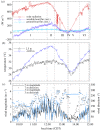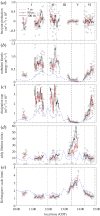Unmanned aerial vehicles reveal the impact of a total solar eclipse on the atmospheric surface layer
- PMID: 31611717
- PMCID: PMC6784406
- DOI: 10.1098/rspa.2019.0212
Unmanned aerial vehicles reveal the impact of a total solar eclipse on the atmospheric surface layer
Abstract
We use unmanned aerial vehicles to interrogate the surface layer processes during a solar eclipse and gain a comprehensive look at the changes made to the atmospheric surface layer as a result of the rapid change of insolation. Measurements of the atmospheric surface layer structure made by the unmanned systems are connected to surface measurements to provide a holistic view of the impact of the eclipse on the near-surface behaviour, large-scale turbulent structures and small-scale turbulent dynamics. Different regimes of atmospheric surface layer behaviour were identified, with the most significant impact including the formation of a stable layer just after totality and evidence of Kelvin-Helmholtz waves appearing at the interface between this layer and the residual layer forming above it. The decrease in surface heating caused a commensurate decrease in buoyant turbulent production, which resulted in a rapid decay of the turbulence in the atmospheric surface layer both within the stable layer and in the mixed layer forming above it. Significant changes in the wind direction were imposed by the decrease in insolation, with evidence supporting the formation of a nocturnal jet, as well as backing of the wind vector within the stable layer.
Keywords: atmospheric surface layer; eclipse; measurements; turbulence; unmanned aerial vehicles.
© 2019 The Author(s).
Conflict of interest statement
We declare we have no competing interests.
Figures








References
-
- Walker G. 2008. An ocean of air: a natural history of the atmosphere. London, UK: Bloomsbury.
-
- Foken T. 2008. Micrometeorology. Berlin, Germany: Springer.
-
- Brown GL, Roshko A. 1974. On density effects and large structure in turbulent mixing layers. J. Fluid Mech. 64, 775–816. (10.1017/S002211207400190X) - DOI
-
- Gao W, Shaw RH, Paw U KT. 1989. Observation of organized structure in turbulent flow within and above a forest canopy. Bound. Layer Meteorol. 59, 35–57. (10.1007/BF00120685) - DOI
-
- Kapoor RK, Adiga BB, Singal SP, Aggarwal SK, Gera BS. 1982. Studies of the atmospheric stability characteristics during the solar eclipse of February 16, 1980. Bound. Layer Meteorol. 24, 415–419. (10.1007/BF00120730) - DOI
LinkOut - more resources
Full Text Sources
